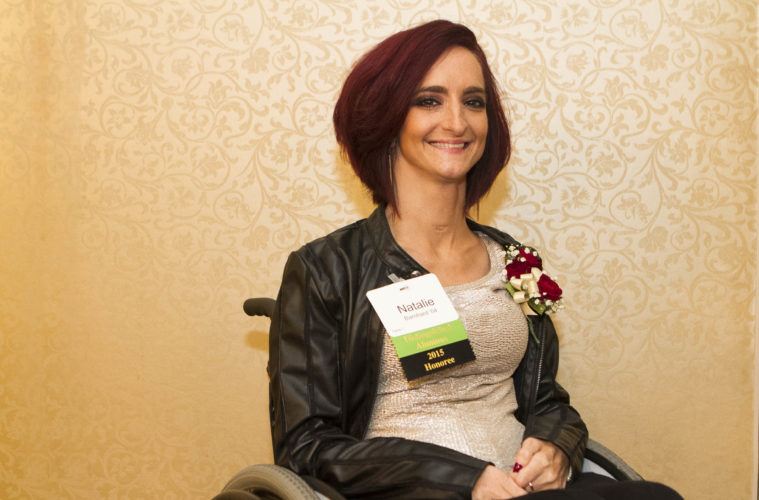 Natalie Barnhard is a Community Activist, Speaker, Entrepreneur and Cure Advocate. Below, she shares her personal experience with the Mitrofanoff procedure as a C5/6 quadriplegic, and why she is a proud user of Cure Catheters.
Natalie Barnhard is a Community Activist, Speaker, Entrepreneur and Cure Advocate. Below, she shares her personal experience with the Mitrofanoff procedure as a C5/6 quadriplegic, and why she is a proud user of Cure Catheters.
A Buffalo, New York native, Natalie Barnhard has been rolling since 2004. She was working as a physical therapist and massage therapist assistant when, one October day, she survived an accident that resulted in a spinal cord injury.
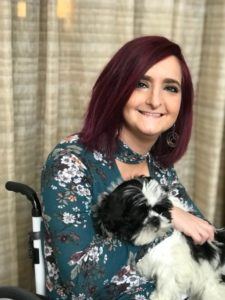
Natalie with her new puppy, Louie
Natalie recalls, “I was at work and had a 600-pound weight machine topple over on top of me, injuring my spine at C-5/C-6. I was 24 at the time.”
“I knew instantly. I couldn’t feel the weight of my body on the ground. It’s a really weird feeling – you feel like you’re floating. Because of my background, I knew what a spinal cord injury was and all about it. I knew right then it was bad.”
Since her spinal cord injury, Natalie has remained active and involved in her community. She participates in ongoing, intensive physical therapy to keep her body in shape and has a strong support network.
Natalie is also an advocate for people with disabilities, working with United Spinal over the years and attending multiple advocacy events, including Roll on Capitol Hill.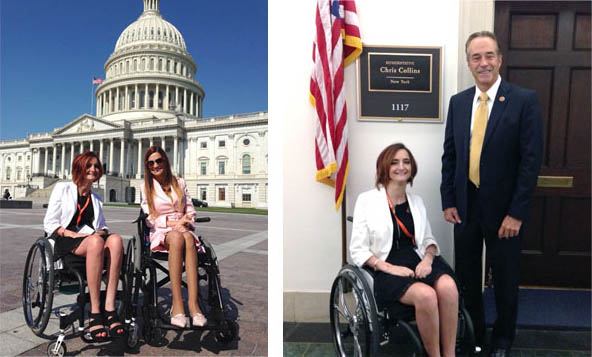 Natalie also started a non-profit for other people with SCI, called Wheels with Wings. “Our mission is about quality of life and we give grants to people with spinal cord injuries for things they need – wheelchairs, sports equipment, rehab, modifications to homes, accessible vehicles. We’ve been extremely successful. We’ve raised just over $250,000 in 5 years, through several annual fundraising events.”
Natalie also started a non-profit for other people with SCI, called Wheels with Wings. “Our mission is about quality of life and we give grants to people with spinal cord injuries for things they need – wheelchairs, sports equipment, rehab, modifications to homes, accessible vehicles. We’ve been extremely successful. We’ve raised just over $250,000 in 5 years, through several annual fundraising events.”
“I’m also working toward starting a local rehab facility in Buffalo. It’s my journey, I think, from being a therapist before to being a therapist in a different way – more of a holistic approach to help people get back on track.”
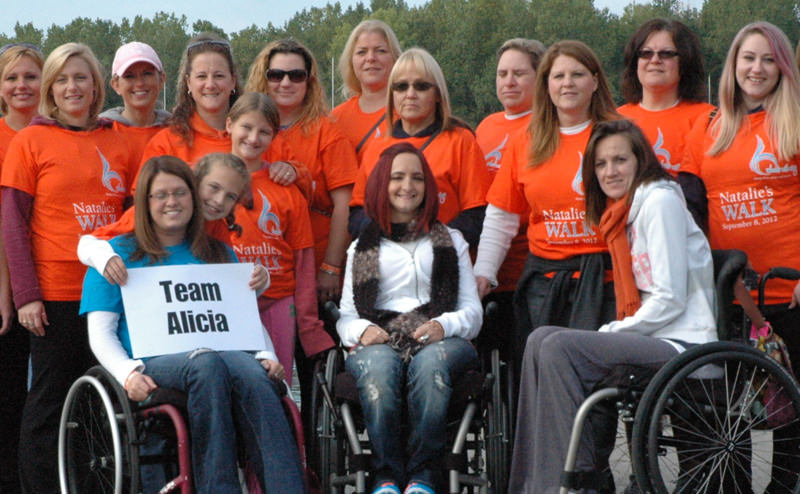 Living an active life as a quadriplegic, however, isn’t without its challenges.
Living an active life as a quadriplegic, however, isn’t without its challenges.
Natalie yearned for increased independence and freedom when it came to her personal care. She had heard friends with similar disabilities talk about a procedure that could possibly give her just that. So, she began researching her options including something called the Mitrofanoff procedure.
What is a Mitrofanoff Procedure?
Professor Paul Mitrofanoff created the Mitrofanoff (mi-trof-fan-off) procedure in 1976. It’s also known as the Mitrofanoff Appendiciovesicostomy or a Continent Urinary Diversion.
The Mitrofanoff was developed to permit bladder drainage where voiding or urethral self-catheterization is not possible. For a patient, the procedure enables them to maintain dignity and means that there is no need to have an indwelling catheter or wear a stoma bag.
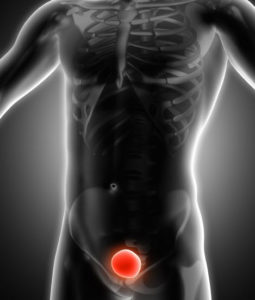
In simple terms, a Mitrofanoff procedure:
- Creates a channel into the bladder
- A catheter is used via the channel to empty the bladder
The procedure may be an option for people who have the following conditions:
- Congenital birth malformations ie; bladder exstrophy, bladder epispadias, spina bifida and neurogenic bladder
- Multiple Sclerosis
- Spinal Cord Injuries and paraplegia
- Bladder cancer patients and in some cases prostate or bowel cancer
Source: https://www.mitrofanoffsupport.org.uk/mitrofanoff-procedure/
Why Natalie decided to Undergo the Mitrofanoff Procedure
Natalie explains, “For me, it was really difficult to use a catheter in my wheelchair because I couldn’t do any of it myself due to my hand dexterity. It was even challenging for one caregiver to help me do it from the chair, so it was easiest to find a place to lay down – which isn’t always convenient. I have definitely had to be creative and I made it work.
I was also starting to have a lot more UTIs. Over the past couple years, my UTIs were non-stop and I was in a lot of pain. My urologist was really concerned about all the antibiotics I was on and I was also experiencing a lot of autonomic dysreflexia.”
 As Natalie considered her options, she talked in depth with several friends that were extremely happy with the Mitrofanoff procedure and the positive lifestyle changes that they enjoyed after having it done.
As Natalie considered her options, she talked in depth with several friends that were extremely happy with the Mitrofanoff procedure and the positive lifestyle changes that they enjoyed after having it done.
She also talked with her family, loved ones and doctors. After fully weighing the benefits and risks, Natalie decided to move forward with her surgery in October 2017.
“I was eager to have the freedom and possibly even teach myself to cath. That would be HUGE. Even if I didn’t get to that point, it would still create a lifestyle change for me. So, I finally decided to take the leap and do it,” she says.
Natalie’s Mitrofanoff Surgery
“It was a major surgery,” Natalie shares. “They said it could take anywhere from 8-10 hours. I did really well and mine took six hours. Due to my prior injuries and surgeries, they weren’t sure what it was going to be like during the operation but it went really smooth. I was healing well in the hospital, which initially was almost two-week stay. After going home, I ran fevers and had to return for another week.”
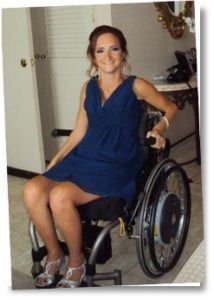 “After this surgery, you leave the hospital with a few tubes,” Natalie shares. “You have an indwelling catheter in your urethra, plus a suprapubic, and then you have a tube in the stoma as well so it doesn’t close up. After your body starts healing, the doctors remove the Foley catheter,” Natalie adds.
“After this surgery, you leave the hospital with a few tubes,” Natalie shares. “You have an indwelling catheter in your urethra, plus a suprapubic, and then you have a tube in the stoma as well so it doesn’t close up. After your body starts healing, the doctors remove the Foley catheter,” Natalie adds.
“Then you can start using the stoma, but the suprapubic remains as a backup. Initially, right out of the gate, my doctors told me there would be mucous in the surgical area, and we learned how to irrigate the area properly to help with that. My doctors also informed me there could be slight leaking while my body got used to things – and that would be normal too,” she says.
Complications After Natalie’s Surgery
At first, things seemed to be going well at first with Natalie’s recovery after her Mitrofanoff surgery. “I was going almost four hours in between cathing by Christmas time, but then, out of nowhere, the stoma started leaking badly. I began working with my doctor to figure out the issues,” Natalie recounts.
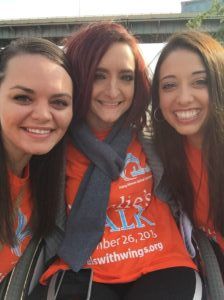
“At one point, I had to go to the ER. Thank goodness there was a urology resident present because my doctor was on vacation. She put in a Foley catheter and flushed it. I was so grateful because I was really hurting. My blood pressure was through the roof,” she says.
Over the last few months, Natalie has continued to experience some leaking, but is still working closely with her doctor to figure out a solution to the problem. Recently, her doctor injected a substance around the stoma (or “valve site”) to firm up the tissue, which seemed to work well.
Despite her challenges post-surgery, Natalie is glad she had the Mitrofanoff procedure done and would still recommend it to others.
“In the little experience I’ve had since my surgery, it has been awesome to be able to cath anywhere. It’s so much easier than how I was cathing before with assistance. You’re just in and out of the restroom,” Natalie says with a smile.
“It’s not a big deal in the middle of the night any more. And, my dad can even help me out now, which we weren’t comfortable with before,” she adds.
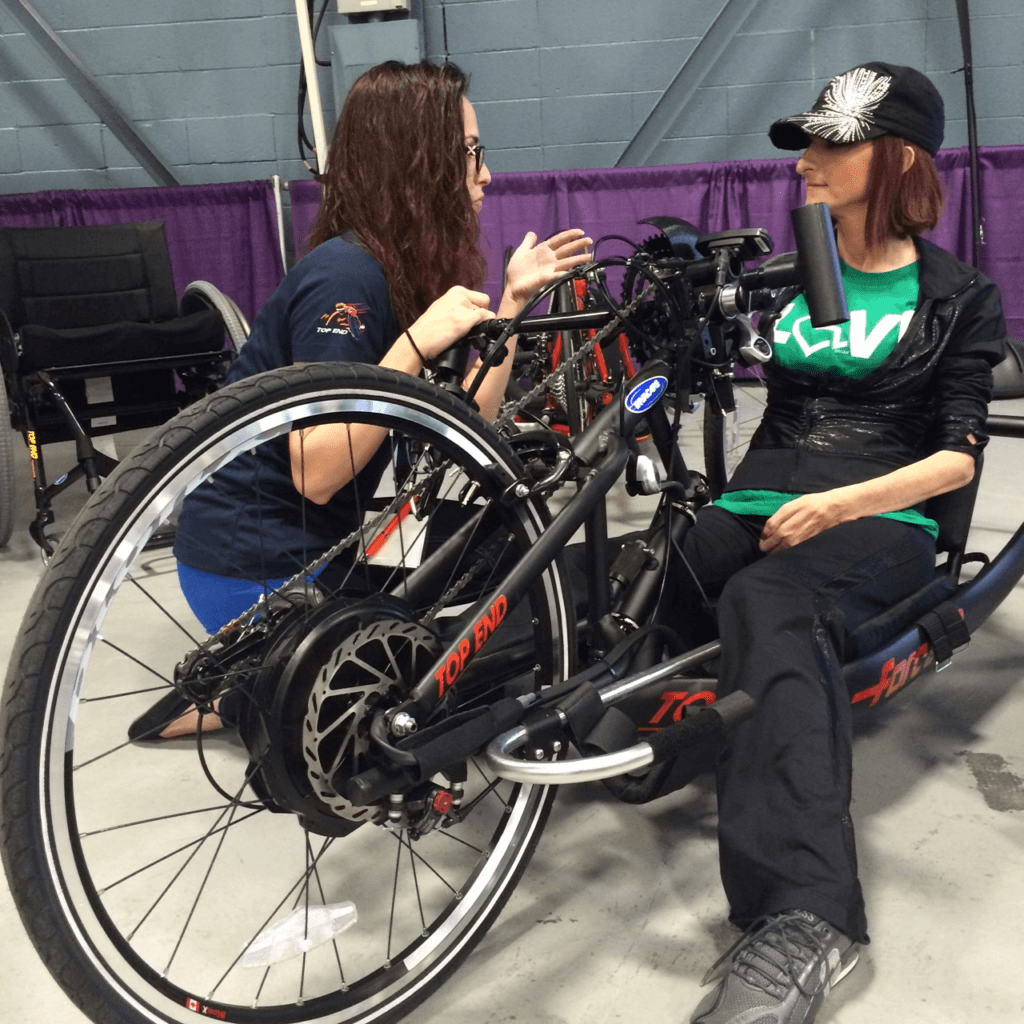
Natalie Barnhard explored the Mitrofanoff procedure because she wanted a more active life as a quadriplegic.
“With anything, when you’re undergoing such a huge change to your body, there will be some risk and unexpected challenges,” Natalie says.
“As of right now, when it’s working, I love it. Everyone I know that has had it too would recommend it, but people should know there are risks to this surgery too,” she cautions.
As final words of wisdom, Natalie says, “Don’t go into this until you’ve done your research, talked to your healthcare professionals and loved ones. I knew what this could do for my life. I’m still optimistic too as it hasn’t even been a year since my operation. There’s a long healing process to this surgery and my body just needs more time.”
Why Natalie Chooses Cure Catheters After Her Mitrofanoff Surgery
After years of cathing with another brand of intermittent catheters, Natalie recently discovered Cure Medical and made the switch. “In the relatively short amount of time I’ve been using Cure catheters, I’ve seen such a positive difference,” Natalie explains.
“The few times that I’ve used the previous brand I had before my surgery, I bled through my stoma. I bled every time I used that other brand. With Cure catheters, I don’t bleed at all.”
Natalie currently uses the Cure Medical M14UK pocket catheter with insertion kit.
CURE MEDICAL® POCKET CATHETER FEATURES
- Smooth polished eyelets provide increased comfort.
- A packet of water soluble lubricant is included to aide in comfortable insertion.
- Large flaps on the pouch enable a better grip for easy opening with minimal effort.
- High quality materials – not made with DEHP*, BPA, or natural rubber latex offer peace of mind.
Read more about the concerns on DEHP here. - Available Sizes: 12FR, 14FR, 16FR
- When you use Cure catheters, you are supporting research in pursuit of a cure for SCI and CNS/D – that’s possibly the best benefit of all!
- Available in USA and Canada
 To request free samples of the new Cure Medical® Pocket Catheter or any Cure Medical® catheter, contact your local distributor of quality healthcare products, or click here.
To request free samples of the new Cure Medical® Pocket Catheter or any Cure Medical® catheter, contact your local distributor of quality healthcare products, or click here.
“The polished eyelets on the Cure catheters make all the difference,” she says.
Natalie also says it’s not just product features that she loves about Cure Medical. She also values the company’s commitment to their customers and SCI research.
“I think the Cure Commitment to spinal cord research is amazing and that, right there, was one of the reasons I fell in love with the company. I told my mom, ‘I would go with this company only for that reason.’ I don’t know any other companies that give 10% of their net income back to SCI and paralysis research,” Natalie states emphatically. Note: This article is for informational use only and should not be construed as medical advice. Always consult your physician with questions related to your individual condition or health needs.
Note: This article is for informational use only and should not be construed as medical advice. Always consult your physician with questions related to your individual condition or health needs.
Enjoy Our Free Resources & Articles
 CURE NATION is designed with you in mind, to offer assistance and education when you need it through a personal support program.
CURE NATION is designed with you in mind, to offer assistance and education when you need it through a personal support program.
All of the information you find below and on our related social media pages is meant to guide you to places, topics and resources that enhance your life, while also connecting you with a growing group of friends.
- Sign up for our free, CURE NATION e-newsletter to have our latest stories delivered directly to you, once a month.
- Get our FREE LIFESTYLE + TRAVEL BOOKS here.
- Have an idea you’d like to share? Let us know.
- Be sure to take minute to meet our Cure Advocates too.
You may also enjoy:
Vancouver's Stubborn Baker Jessica Kruger Shares Her SCI Ingenuity
Five Accessible National Parks You Can Visit On Wheels for Free
Accessible Living By Design: Steve Bertasso Helps You Adjust Like He Did
Sara Gaver: It Doesn’t Matter if I Win, I Always Push for More
Meet Us in Houston for the Abilities Expo!
Hit the Waves with Stoke for Life Adaptive Surfing
Introducing the Cure Ultra: Ready to Use Catheter for Men
Dear Journalists & Media Professionals: Language Matters When Describing Disability

